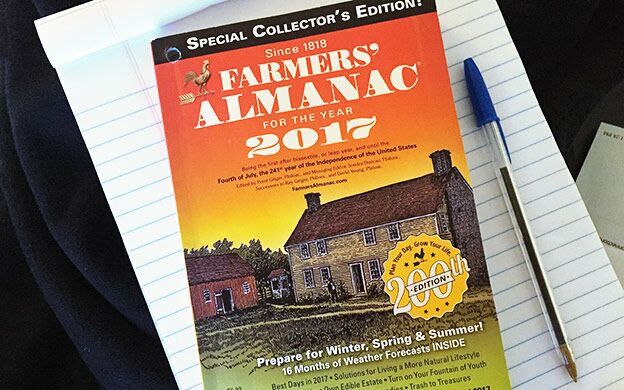Farmers' Almanac predicts cold winter (with a grain of salt)
 Photo / Peter Van Allen
The Lewiston-based Farmers' Almanac just released its 200th edition.
Photo / Peter Van Allen
The Lewiston-based Farmers' Almanac just released its 200th edition.
The Lewiston-based Farmers’ Almanac is calling for an “ice cold and snow-filled” winter in the Northeast — and stirring up a lot of weather talk nationwide.
The publication, which just released its 200th edition, is known for its long-range weather predictions — packaged in 216 pages with an orange cover.
“Accurate long-range weather predictions have been what people associate with the Farmers’ Almanac,” said Peter Geiger, editor of the publication, which has 235 employees in Lewiston.
The Farmers’ Almanac is known for its early forecasts, predicting more than 18 months into the future, including this year’s call for an “old fashioned winter.”
Geiger cites the example of a woman who said she’d ordered an extra cord of wood and topped off her oil tank after reading the Farmers’ Almanac prediction for winter.
Late NFL Coach Dennis Green, who died in July, used to use the Farmers’ Almanac to create his training camp schedules, Jarrett Bell, an NFL writer at USA Today, told ESPN.
Last week, WLS7 in Chicago warned of a “numbingly cold winter” and quoted Geiger as saying the Windy City should brace for temperatures as low as 40 below.
But one Cleveland station debunked the forecast because the Farmers’ Almanac doesn’t use long-term computer models for its predictions — or any computers, for that matter. “The science of meteorology has come a LONG way since 1818,” said Matt Holiner, a meteorologist at Fox19 in Cleveland.
If you don’t like the forecast, you could always consult the Farmers’ Almanac’s chief competitor, the Old Farmer’s Almanac, which is calling for a cold and wet winter. The Old Farmer’s Almanac is published in Dublin, N.H., by Yankee Publishing Inc. Each has a long history: The Farmers’ Almanac dates to 1818 (it moved from Newark, N.J., to Lewiston in 1955) and the Old Farmer’s Almanac dates to 1793.
An NPR story in 2014 delved into the accuracy of long-term forecasting, “Punxsutawney Phil vs. the Farmers’ Almanac: Whom do you trust?” It found the almanac predictions to be accurate to a point.
As told to NPR, Penn State meteorologist Paul Knight said of the Farmers’ Almanac: "[They] say from November 5 thru 10, for that whole period: sunny/cool. If one day is sunny and cool, does that count? Does every day have to be sunny and cool? If you held them to every single word for the entire area and every word for the entire period, then I say they might not even be right one third of the time."
Read more
Warm weather cuts smelt season early
L.L.Bean sales remain flat, as mild winter slowed demand
Sugar houses tweak schedules for Maine Maple Sunday, Easter overlap










Comments